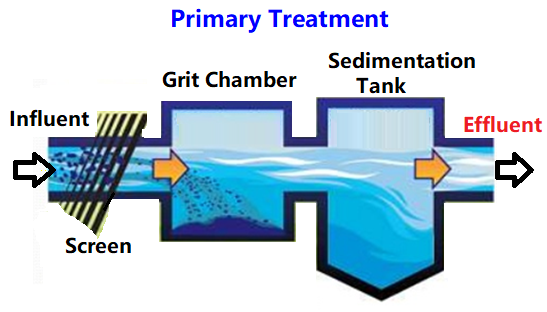Primary Treatment of Wastewater

Primary Treatment of Wastewater is a process designed to remove pollutants and contaminants from water before it is discharged into the environment or reused. The primary treatment is the initial stage of this process, where physical methods are employed to separate solid and large particulate matter from the wastewater. This helps in reducing the overall pollutant load and facilitates the subsequent treatment processes.
How Does Primary Treatment of Wastewater Work?
Screening:
Purpose: The first step in primary treatment is screening. Wastewater often contains large objects such as sticks, leaves, plastic, and other debris. Screening is designed to remove these larger materials to prevent damage to pumps, pipes, and other downstream equipment.
Process: Wastewater flows through a series of screens with openings of varying sizes. These screens can be coarse or fine, depending on the specific needs of the treatment plant. The screens capture and remove larger objects from the wastewater stream.
Primary Sedimentation:
Purpose: After screening, the wastewater moves to primary sedimentation tanks. The primary goal here is to allow the settling of suspended solids, which are particles that are too small or light to settle on their own.
Process: The wastewater enters large, open tanks where the flow velocity is reduced significantly. This reduction in velocity allows gravity to take effect. Heavier particles, known as primary sludge, settle to the bottom of the tank. This sludge includes organic and inorganic solids.
Separation: The settled sludge is periodically removed from the bottom of the tank and sent for further treatment (e.g., anaerobic digestion or incineration). The clarified water, now with reduced levels of suspended solids, flows out of the tank for further treatment in secondary and tertiary stages.
Main Objectives of Wastewater Primary Treatment
- The removal of floating materials, or “scum,” that floats on the surface is the primary goal of primary treatment. Grease, oils, organic matter, and other lighter solids can all be found in scum.
- Usually, the primary treatment is the first step before more wastewater treatments.
- Research has shown that primary treatment of wastewater can improve the settling characteristics and quality of wastewaters that are difficult to treat otherwise.
- The primary treatment of sewage has the advantage of lowering wastewater’s BOD (Biological Oxygen Demand).
- The most important goal of this procedure is to remove settleable solids.
What are the Processes of Primary Treatment of Wastewater?
1. Screening:
Objective: Removal of large debris and objects to protect downstream equipment.
Process: Wastewater passes through screens with varying mesh sizes to capture and remove larger objects such as sticks, leaves, plastics, and other debris.
2. Primary Sedimentation:
Objective: Settling of suspended solids to reduce the overall pollutant load.
Process: After screening, the wastewater flows into primary sedimentation tanks. The flow velocity is reduced in these tanks, allowing gravity to settle heavier particles. The settled material, known as primary sludge, is collected at the bottom of the tanks.
3. Primary Clarifiers:
Objective: enhanced settling of solids to improve water clarity.
Process: Like primary sedimentation tanks, primary clarifiers provide additional settling time for suspended solids. These tanks may have mechanical scrapers to remove the settled sludge more efficiently.
4. Equalization:
Objective: Balancing and smoothing variations in wastewater flow and pollutant concentrations.
Process: Equalization tanks help buffer the fluctuations in wastewater flow and characteristics, ensuring a more consistent influent for downstream treatment processes.
5. Grit Removal:
Objective: Removal of heavy inorganic particles like sand and gravel.
Process: Grit chambers are used to allow the settling of heavier particles, such as sand and gravel, which can cause abrasion and damage to equipment if not removed.
6. Primary Sludge Treatment:
Objective: Management and further treatment of the collected primary sludge.
Process: The primary sludge collected in sedimentation tanks is often pumped to further treatment processes, such as anaerobic digestion, to stabilize the organic content and reduce its volume.
The Importance of Primary Treatment
The first stage of the treatment process, primary wastewater treatment, is crucial to converting wastewater into clean water that can be recycled or safely returned to a natural source.
Larger particles and contaminants that could harm the machinery utilized in later phases and the plant’s remaining treatment procedures are eliminated during the primary treatment of wastewater. Maintaining the efficacy of wastewater treatment requires completing this initial step.
As was previously mentioned, primary sewage treatment includes screening, sedimentation, and primary clarifiers to prepare water for additional filtration while removing solids that could harm secondary wastewater treatment equipment.
Primary VS Secondary Wastewater Treatment
To produce freshwater, two distinct stages of sewage treatment—primary and secondary treatment—are required.
The primary goal of treating sewage is to separate the solids and get the wastewater ready for the system’s second stage of treatment. Rather, water that has undergone secondary treatment is devoid of solids and has significantly lower levels of contaminants.
Secondary treatment for municipal sewage typically involves biological processes like oxidation, aeration, and biofiltration. The recommended treatment techniques can differ in applications for treating industrial effluents.
Large materials are removed from wastewater by the first and primary water treatment processes, and smaller particles that have already dissolved or suspended are removed by the secondary treatment. The primary treatment method involves filtration and sedimentation, while secondary processes use aerobic or anaerobic units to facilitate biological breakdown.
The duration required to finish each of these procedures varies as well. While the organic microbes in the secondary treatment process take a lot longer to digest the waste, the primary treatment is completed much faster.